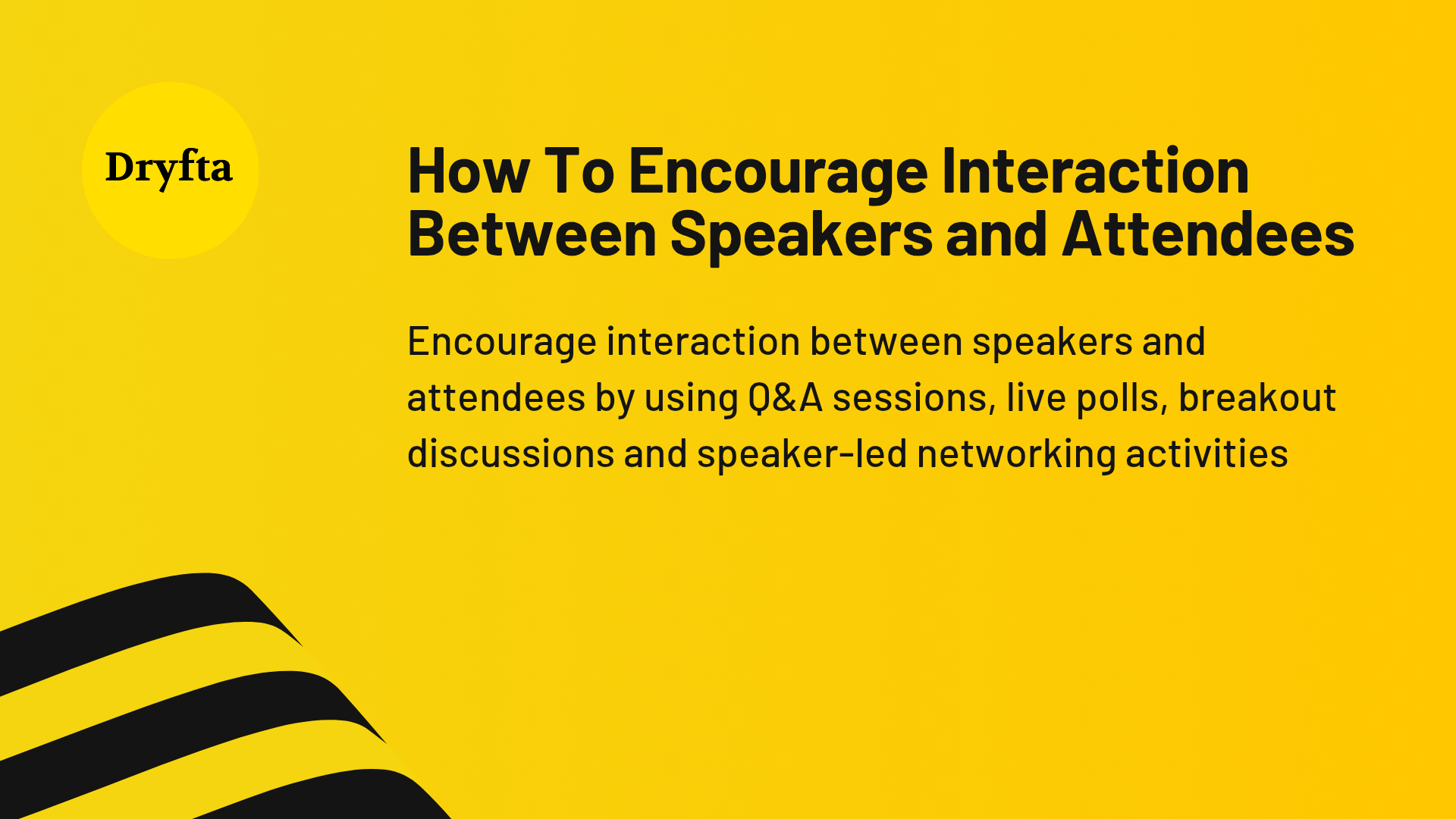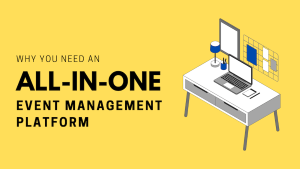
According to a survey by Umbrek, only about 40-70% of your audience are active attendees. The other half leave your event without ever speaking to the speakers they came to hear. This is the grim reality when event planners fail to encourage interaction between attendees and speakers in their events.
Therefore, I would like you to take a moment to ponder what fate awaits your next conference. Ask yourself:
Have I taken steps to encourage interaction in my conference room? Or am I at risk of falling into the familiar pitfall of attendee disengagement?
Well, am I willing, in the first place, to acknowledge the fact that a substantial portion of my attendees are not truly involved?
Will I pull off a meaningful and productive experience or will I come face-to-face with swift disappointment in my post-event surveys?
On that note, I’d like to ask you: Will your attendees remain sufficiently engaged until the very end to fill out your post-event survey? Will they ever return for a second time?
This is The Reality of Passive Events
We often make bad decisions in event planning that we regret later on. But we can only wish that our missteps are never as costly as hosting an entire conference where speakers talk to audiences for hours and attendees sit silently checking their phones. It turns out that many event planners mistake filling seats for creating value.
In this blog, let’s take a quick look at what are some of the most effective strategies to encourage interaction between speakers and attendees at your next event. Read till the end and you will also discover some common mistakes you keep making that are holding your conference down.
Pre-Event Setup Armed with Interaction Design
When it comes to your event experience, even the seemingly minor details matter. Your session formats, time allocations and speaker briefings determine whether interaction happens naturally or gets squeezed out entirely. Missing interaction opportunities, inaccurate time estimates and other errors in your event design can lead to immediate disengagement.
Traditional lecture formats simply don’t work anymore. A speaker presenting for 45 minutes, followed by a rushed 5-minute Q&A? That’s not interaction. That’s a lecture with an awkward ending where three brave souls ask questions nobody else cares about.
Consider these format alternatives:
-
- Panel discussions where multiple experts debate topics in real time
- Fireside chats with conversational interviews instead of monologues
- Workshop sessions where attendees work through problems alongside speakers
- Roundtable conversations limited to 20-30 people for intimate discussion
The moment you implement these changes, attendees realize this event operates differently from the passive conferences they’re used to sitting through.
Technology Capable of Complete Engagement
Your event technology determines whether interaction flows smoothly or becomes frustratingly complicated. The wrong tools act like barriers between speakers and attendees. The right tools? They’re capable of complete transformation in how people connect.
Modern event platforms offer multiple interaction weapons:
-
- Live Q&A Systems: Tools or built-in event app features let attendees submit questions digitally during presentations. Moderators can filter questions, upvote popular ones and make certain the best questions get answered. This solves multiple problems: shy attendees who won’t raise their hands can participate. Speakers can see questions building up in real time.
- Live Polling: Speakers can launch real-time polls to gauge audience opinions, test knowledge or spark discussions. When poll results appear on screen immediately, attendees see their collective input visualized. They’re no longer passive observers.
- Networking Apps: Event mobile apps with attendee directories and messaging functions let participants connect with speakers before and after sessions. When speakers opt into these tools and actually respond to messages, interaction extends far beyond the session room.
Room Layouts That Hunt Down Distance
Conference seating creates psychological and physical distance. Audiences face forward in neat rows, making peer discussion awkward. Speakers stand on elevated stages, separated from attendees by literal height differences. Oh, how this setup has failed event organizers for decades!
Consider these alternative configurations:
-
- Roundtable seating: Tables with 6-8 people facilitate both speaker interaction and peer discussion. Speakers can move between tables during breakout discussions. Attendees can turn to each other for small group conversations without disrupting the entire room.
- U-shape or hollow square: Everyone can see each other, creating an intimate discussion atmosphere. This works particularly well for sessions with 20-40 attendees where you want high interaction levels.
- Cabaret style: Round tables positioned at angles toward the speaker allow note-taking during presentations and easy conversation during discussion periods. This is the Swiss Army knife of seating arrangements.
- Standing reception format: For networking sessions with speakers, eliminate seating entirely. Standing naturally encourages movement and mingling. People approach speakers more easily when there’s no physical barrier of chairs and tables to cross.
- Lower the stage: If you must use theater seating for large sessions, minimize stage height. Speakers at ground level or on low risers feel accessible. Speakers on high platforms might as well be on distant warships for all the connection attendees feel.
Moderators Who Give Chase to Engagement
Nearly an hour of intense facilitation later, good moderators can transform even reluctant speakers into engagement champions. Skilled moderation is not built to give up on interaction, even when sessions start running long or speakers dominate the conversation.
Assign trained moderators to manage speaker sessions. Good moderators function like a crew on board a ship: alert, responsive and ready to take action when situations demand it.
Set the tone early: Open sessions by explaining how interaction will work. Tell attendees when they can ask questions, how to use technology tools and what level of participation you expect. This prevents confusion and gives permission for engagement.
Monitor time aggressively: Stop speakers who run long on presentations. Protect discussion time as fiercely as presentation time. When interaction time gets cut short repeatedly, attendees notice. They learn that engagement is actually optional, despite what you claimed earlier.
Draw out quiet voices: Some attendees hesitate to speak publicly. Skilled moderators can say, “I noticed several people nodding at that point. Would someone like to share their experience?” This gives permission without putting individuals on the spot uncomfortably.
Redirect off-topic questions: When someone asks an overly specific question relevant only to their unique situation, good moderators acknowledge it and then suggest connecting with the speaker afterward. This keeps sessions valuable for everyone rather than becoming free consulting for one person.
It was in these facilitated moments, amidst the careful time management and skilled question handling, that attendees realized interaction is actually happening rather than just being promised.
Common Mistakes That Invite Downfall
Truly, event organizers who ignore interaction seem to have invited their own disappointing satisfaction scores. Since you have read this far, here are some common mistakes to avoid:
Mistake 1: Treating Interaction as Optional
Don’t position engagement as something nice to have if time permits. Build it into your core event design from the beginning. When you treat interaction as optional, speakers will claim that time for extended presentations every single time.
Mistake 2: Believing Technology Solves Everything
Q&A apps are tools, not solutions. You still need skilled moderators, clear processes and speaker buy-in. Technology amplifies good interaction design but can’t fix fundamentally passive event structures.
Mistake 3: Ignoring Personality Differences
Not everyone thrives in public Q&A sessions. Introverted attendees prefer written questions or one-on-one conversations. Offer multiple interaction channels so different personality types can engage comfortably.
Mistake 4: Skipping Moderator Training
Even experienced moderators need event-specific training. Brief them on your interaction priorities, technology tools and how to handle difficult situations like overly talkative attendees or controversial questions that derail discussions.
Mistake 5: Scheduling Interaction at the Wrong Times
Interaction works best when audiences are alert. Don’t schedule your most interactive sessions right after lunch when everyone’s drowsy or at day’s end when people are mentally exhausted and thinking about dinner plans.
The Magic of Interaction Design is Just Good Planning
Most motivated event planners will agree that investing in and paying attention to interaction design is a non-negotiable in hosting events today. A select few may give in and make peace with the notion that passive attendance is simply how conferences work.
At Dryfta, we strongly latch on to the former. Our vision is to help event planners like you build and sustain genuine speaker-attendee interaction. To achieve this, we commit to exploring new formats and technology. Half-measures produce half-results; hence, we go all in. Quit hosting passive events where attendees sit silently and speakers talk to audiences from distant stages today. Schedule a free demo today!




